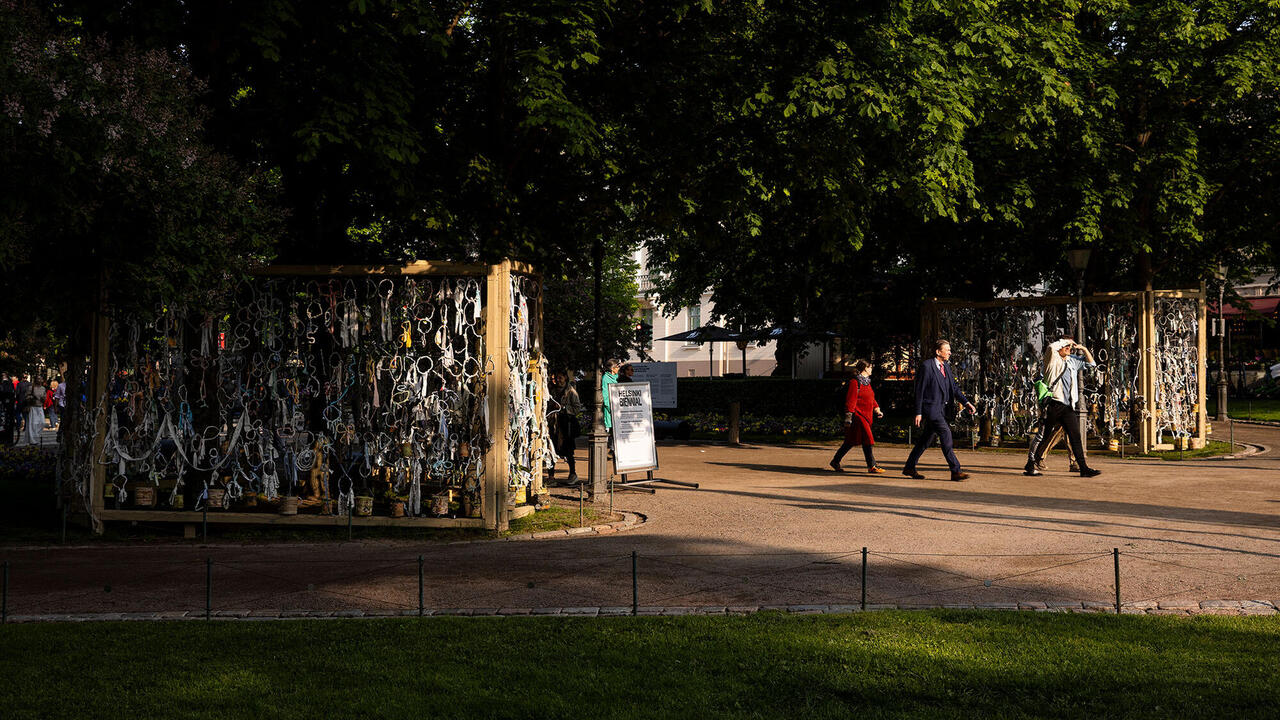Sam Taylor-Wood
Sam Taylor-Wood's Travesty of a Mockery (1995) consists of two video projections of a man and a woman engaged in a fierce domestic argument. Imagine the more bitter and twisted scenes from Chelsea Girls, Oprah... your life. The projections are separated by a corner of the gallery so the flow of abuse travels from one wall to the other, back and forth - she feels rejected, while he despises her pleas for affection. Framed by a featureless wall and a canvas blind, he (unshaven, black T-shirt and jeans) appears within a relatively bleak environment, whereas she (copper bob, turquoise shirt and black trousers) is firmly located in the turmoil of the kitchen. As a useful measure of their close proximity, she occasionally hurls a cooking pot or a cigarette lighter from one projection to the other. The press release informs us that she, Amanda Ooms, is a professional actress, whereas il bruto is not.
In the opening sequence, she holds a cigarette between her trembling fingers while he broods in his chair. For the time being, there's no talking, just daggers. Abrupt interference erases the image and we hear a radio being re-tuned to another station - each short-lived scene is accompanied by snatches of opera, rock, classical or jungle. In the time it takes to change a TV channel, the picture returns. She bangs on the table, 'What do you need?' Again, the picture disintegrates and we return later, or so it seems, to find her screaming 'Get out of my face!' Meanwhile, he's out of his chair calling her a screwball. Scene five, she throws a glass of milk over his face. Scene seven, he rushes over from his projection and reaches out to strangle her - cut! Unexpectedly, she beckons him over, they kiss and as he steps back his hand falls over her right breast. At which point she spits in his face. In another scene, he manhandles her against the fridge while she attempts to knee him in the balls - 'I don't just want you to fuck me!' Then she appears in his projection, he runs into frame and throws her from one side of the kitchen to the other - 'Get out of my chair!' Overall, the tension is finally balanced between scenes where she does little more than take her socks off, and those where she slaps him across the face. All for real.
In the White Cube office - a casual acquaintance of the main gallery - we find two 360° panoramic photographs entitled Five Revolutionary Seconds Nos. 1 & 2 (both 1995). Taken in plush town houses, each photograph is punctuated with emotional incidents ranging from major to minor: someone playing a piano; a man being dragged into bed; a phone call; a naked man in a doorway. Five Revolutionary Seconds No. 1 contains the prototype argument and exists elsewhere - not here - as a large-scale photographic print accompanied by a sound recording of events; something akin to an audio tracking shot. As the row going on in Travesty... drifts through from nextdoor, it is possible to assess how these sketchbook-style images were intended to work. From left to right, the arrangement of incidents is surprisingly melodic - exponents of new musical notation may even consider these photographs playable.
In 1993 Taylor-Wood exhibited 16mm, a home movie of herself dancing to the surround-sound of machine gun fire; a clamour which suggests that the artist's jerks and spasms are due to a hail of bullets aimed at her feet. Echoes of this are present in Brontosaurus (1995), a stirring video of a naked man shaking his thang to Samuel Barber's Adagio for Strings. Recent bridgework includes the video quartet Killing Time (1994) - invariably described as a slacker-opera - and Method in Madness (1995), a tortuous portrayal of an actor performing a nervous breakdown. These works reveal a fascination with cinematic representations of extreme emotion and Taylor-Wood's directorial predilection to compromise her cast. Inspired by Cassavetes, Coppola, Cimino and Scorsese, Travesty... looks like a downtown class in experimental acting. Selected for their polarity of acting skills and instructed to hate one another, the actors embark on a whole lot of screaming and shouting. Whether this qualifies as acting, good or bad, remains uncertain. Accordingly, it is difficult to determine whether he is as good
an actor as her when the script - reportedly abandoned - is superseded by an emotional rampage. And so we are left to determine where the acting occurs, if at all, and where the reality of the dispute lies. Reminiscent of Mick Jagger's insightful theatrics in Donald Cammell and Nicolas Roeg's Performance, Travesty Of a Mockery does well in remembering that the ultimate thespian achievement, 'the one that makes it all the way', is true madness.
















